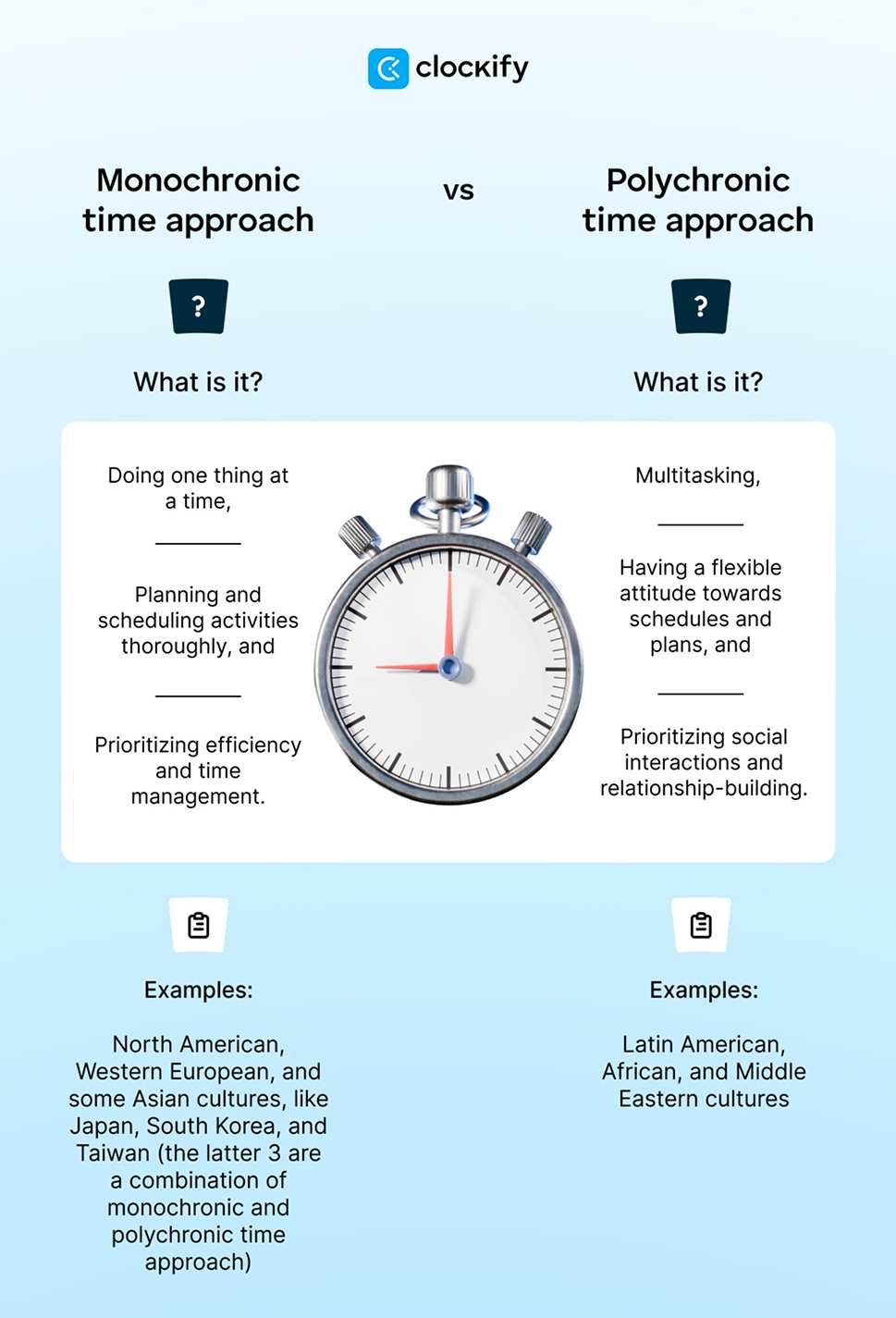If you live in the US, you may catch yourself looking at the clock and keeping track of your appointments in a calendar. But, does every culture view time this way?
Different cultures developed various views on time use. For example, what is usual in some Latin countries may be completely unacceptable in Western cultures. Similarly, being tardy in the US means losing money, while running late in Brazil is considered completely acceptable.
In this text, we’ll explore how different cultures perceive time, how they measure it, the role of time in communication, and more.
Let’s dive in.

Table of Contents
What is time in society and culture?
Although time is a universal aspect of everyday life, how people think about it differs across cultures.
Psychologist Robert Levine explored these differences in his book A Geography of Time. He found that more economically developed places, like North America, Northern Europe, and certain Asian countries, such as Japan, are fast-paced. That is to say, such countries greatly value time since, to them, time is money.
On the other hand, countries with less developed economies are considered slow-paced. Cultures such as the Middle East and Latin America nurture a relaxed attitude towards time. They are more family and socially-oriented.
Thus, people’s attitudes towards time depend on their cultural traditions, beliefs, and socioeconomic status.
Timekeeping in different cultures
Western cultures, including some parts of East Asia, such as Japan, tend to measure their time by the clock. They believe that each activity should have a precise beginning and end.
Conversely, measuring time in Eastern cultures is event or personality-related. In other words, each activity should begin and end naturally, that is, when the participants feel it should begin and end.

In some event-time societies, such as India, activities may occur in coordinated sequences. For example, during an Indian wake, attendees transition from gathering to prayer, singing, intermission, and mealtime. However, they move when they feel the time is right without concern for the clock.
Time orientation: past, present, and future-oriented cultures
Nations with a long history that survived wars, had past achievements, or lived in monarchies hold on to the past more than nations with a relatively short history. This era-based understanding of time is called time orientation.
In this sense, cultures are divided into:
- Past-oriented,
- Present-oriented, or
- Future-oriented.
We’ve prepared a more detailed description of each orientation below.
#1: Past-oriented cultures
These cultures don’t have long-term perspectives and are resistant to change.
Italy is an ideal example of a past-oriented country. Italians are known for their exquisite craftsmanship and artistic history. They stick to their past achievements and obtain new ones, relying on the knowledge of their ancestors.
Moreover, Britain and China are past-oriented since they have a long history, too. Like the Italians, they are proud of their past achievements and live their lives respecting their traditions and beliefs.
Interestingly, even though the Chinese are past-oriented, they have a long-term perspective. They cherish their traditions yet carefully plan for the future of their heirs.
Past-oriented cultures view time as a vital source of wisdom and guidance. They use past experiences as a model for living today.
#2: Present-oriented cultures
Present-oriented cultures include the majority of Latin American and African countries. For them, what happened in the past should stay there.
Moreover, they are laid-back about future events. In fact, these cultures pay little attention to the future because they view it as uncertain and unknown. As a result, they often lack detailed plans for what’s coming.
In short, present-oriented societies perceive time as immediate and are focused on the current moment.
#3: Future-oriented cultures
Finally, cultures that are forward-thinking are future-oriented. The US is such an example.
They live in the present to the fullest — but are mainly interested in topics related to future events. This may have to do with the fact that they are a relatively young country, at least compared to European countries. Besides, they are known to be thorough planners. For example, they meticulously plan their vacations, meetings, and important events well in advance.
For future-oriented cultures, time is viewed as a valuable resource that should be directed toward progress, goals, and innovation.
💡 CLOCKIFY PRO TIP
Want to effectively set and achieve your goals? To do that, you should follow a few simple steps. So, read the blog post below:
Chronemics: polychronic vs. monochronic time
Chronemics examines how time impacts communication — that is, how people perceive and value time in interactions.
People and organizations in different cultures have different understandings of the use of time in communication, specifically, nonverbal communication. We’ll single out 2 types of such time use:
- Monochronic time (M-time), and
- Polychronic time (P-time).
Event or personality-related cultures use the polychronic approach, while by-the-clock cultures use the monochronic approach.
Let’s learn more about each of these approaches below.
Type #1: Monochronic approach
The monochronic approach includes doing one thing at a time, strictly sticking to schedules, and making thorough plans. People who are comfortable with this time use are task-oriented. Therefore, they don’t let anyone or anything interfere with their daily goals.
Monochronic cultures include Western cultures such as North America and Western Europe, as well as some Asian countries like Japan, Taiwan, and South Korea. Overall, the latter 3 countries combine monochronic and polychronic time use.
For instance, when it comes to business and deadlines, Japan, Taiwan, and South Korea incline towards monochronic time use. As for activities that include building relationships, they lean towards the polychronic approach. In other words, these activities are spontaneous and not thoroughly planned.
At work, M-time people:
- Avoid multitasking,
- Plan and schedule their activities thoroughly,
- Disapprove of tardiness,
- Stay at work until everything is finished,
- Meet deadlines, and
- Refrain from wasting time chatting with colleagues.
💡 CLOCKIFY PRO TIP
Interested in finding out more about the biggest time-wasters at work and how to reduce them? Check out the following blog post:
Type #2: Polychronic approach
People inclined towards the polychronic time approach are driven by emotion and events. Therefore, they are more people-oriented because they prioritize family and social life over work.
Polychronic cultures include Latin American, African, and Middle Eastern cultures. Their attitude towards work includes doing several things at once without paying too much attention to time.
P-time people don’t stick to the schedule so rigidly. In addition, polychronic organizations are externally focused, and their primary concern is customer satisfaction. They follow market trends and prioritize customer feedback.
At work, P-time people:
- Have a flexible attitude towards schedules and plans,
- Group tasks together and perform them simultaneously,
- Build strong relationships with people,
- Avoid judging tardiness,
- Change, delete, or procrastinate items on their to-do lists frequently, and
- Prioritize tasks and adjust them to their needs.

Monochronic and polychronic cultures in business
Monochronic and polychronic cultures may have misunderstandings in business encounters. For instance, polychrons don’t have a defined time frame for each meeting. Eastern people start their business meetings by getting to know their partners more and giving them time to introduce themselves. Their meetings last until they achieve goals in the course of nature.
Conversely, monochronic North Americans like to get to the point and achieve goals in a defined time frame. They have no time to waste.
Furthermore, as per an article on the premature return of expats, the inability to adjust to a different culture is one of the main reasons expats return home early. This usually happens because they go abroad unprepared and unaware of cultural differences, including differences in cultural perceptions of time.
An example of a cross-cultural misunderstanding between a monochronic and a polychronic culture
A North American flies to Istanbul for an annual meeting with his Turkish partners. Punctual as he is, the North American finds it very odd to see people mingling and chatting during work time. He also seems surprised that the meeting didn’t start on time and that his partners extended it spontaneously.
What he doesn’t know is that Turkish people put great value on building social relationships. Thus, good relationships between coworkers are of the essence. Turkish people run meetings on the spur of the moment without forcing them to end at a certain time to achieve instant goals.
Different cultures should be aware of the cultural differences in order to enjoy their encounters more and obtain mutual benefits. Hence, you should always research the cultures of your teammates (if they’re different from yours) to avoid surprises.
How to prevent cross-cultural misunderstanding when doing business
To establish a successful overseas partnership, some ground rules need to be defined. Companies that have a positive outcome when sending people abroad follow specific rules, including:
- They only send culturally literate people or people who find it easy to adapt to changes.
- Expats and hosts should get familiar with each other’s customs to avoid misinterpretations.
- Executives should prepare their expats in advance by providing adequate training, including business etiquette and language training.
- Expats should dismiss any stereotypes about certain cultures (e.g., All Chinese people eat dog meat — this is incorrect, as only a minority located in the Guangxi and Guangdong regions does so).
Understanding each other and respecting cultural differences can generate innovative ideas. Moreover, expats shouldn’t be afraid to communicate with locals, even though their knowledge of the local language may not be advanced.
Once they start communicating with locals more, they’ll find it easier to adapt to culture-specific elements of their everyday lives — including that culture’s sense of time.
💡 CLOCKIFY PRO TIP
To learn more about cross-cultural barriers and how to overcome them in the workplace, read the blog post below:
How cultures perceive punctuality, waiting, and silence
In his 1959 book The Silent Language, anthropologist Edward Hall described cultural rules of time as the “silent language.” According to him, time can sometimes convey content more clearly than words. In line with that, people in India are comfortable with sitting in silence for hours, as opposed to the US, where sitting in silence would feel awkward.
Read on to see how different cultures understand punctuality, waiting, and silence.
Punctuality in different cultures
In his book A Geography of Time, Robert Levine writes about his experience working as a psychology professor in Brazil. He describes how anxious he felt, primarily due to his concerns about potential language barriers.
Yet, he had no idea that the biggest eye-opener would be differences in attitude towards time and punctuality. The psychologist found it surprising that students would often come to class late for more than an hour (for a lecture that lasted 2 hours). Additionally, they would stay long after the lesson was officially over.
Levine’s Brazilian students didn’t seem to be bothered by minutes or hours as his students back home in California. They would spend the last 10 minutes looking at the clock and jostling each other to leave the classroom.
At the same time, punctuality-conscious countries such as Germany, the US, or Switzerland apologize for being 5 minutes late for a meeting. In fact, in these countries, coming on time for a meeting is considered late. Participants should arrive 10-15 minutes before the meeting. For the Swiss, punctuality isn’t just a nicety — it’s a fundamental aspect of their way of life.
Waiting in different cultures
In Eastern cultures, where the polychronic time approach prevails, people don’t find waiting so concerning. Queuing is an everyday thing in polychronic cultures. If the client in a bank is an acquaintance of the bank officer, it’s perfectly fine if they indulge in a private talk. In addition, there’s a rule of hierarchy in these cultures.
High-status people have multiple meetings throughout the workday and thus don’t need to apologize for being late. Psychologists Richard Brislin and Eugene Kim described waiting as an “indication of status” and that “the more power and influence you have, the longer you can make people wait for you.” In India, for instance, the law of the strongest prevails — the one who pushes through the crowds will go first.
Monochronic cultures think of waiting as losing precious time and money. Japanese trains are among the most punctual in the world. If a train is delayed by even a minute, it’s customary for the train company to issue a formal apology to passengers.
Silence in different cultures
Eastern cultures are quite comfortable being silent. They think of silence as a valuable time to reconsider their decisions or actions. Asian people are very respectful and would remain silent throughout the entire conversation and never interrupt a speaker.
But this silence may have an additional meaning. For instance, if the Japanese remain silent during a business meeting, they aren’t comfortable with a proposal and are waiting for a concession.
On the other hand, Western cultures may find silence awkward. As a result, they try to fill in the silence with small talk. In Italy or Spain, everybody speaks at the same time, and interrupting a speaker isn’t disrespectful. Furthermore, remaining silent after a question means that you don’t know the answer.
FAQs about time perception and time use in different cultures
In this section, we’ll provide answers to some of the frequently asked questions about time perception and time use in different cultures.
What is chronoception?
Terms like “chronoception,” “the sense of time,” and “the perception of time” all refer to the same thing — how humans perceive the passage of time. Chronoception is a subjective experience involving how individuals perceive the duration of events or time intervals between them. The perceived time interval between two consecutive events is known as perceived duration or interval perception.
Chronoception varies based on attention, age, emotional engagement, and other factors.
Does the sense of time change with age?
There’s a theory that time passes faster as we age. Experts suggest that this perception is primarily due to the fact that we have fewer new experiences and absorb less visual information (the more information our minds process, the slower time passes). This decrease in new visual stimuli leads us to believe that time passes more quickly.
💡 CLOCKIFY PRO TIP
For some useful tips on how to make time go faster at work, check out the following blog post:
How does the pace of life vary across cultures?
Eastern cultures typically embrace a slower lifestyle, while Western societies are fast-paced. According to an article on the pace of life, a fast-paced lifestyle associated with certain countries, such as the US, can negatively impact physical and psychological well-being. Apart from being linked to higher death rates due to heart disease, a fast-paced lifestyle often leads to people feeling unhappy. This mostly happens because people feel a constant sense of urgency, causing them to forget to enjoy the present.
How do different cultures prioritize work versus leisure time?
Task-oriented cultures, such as the US and some Asian countries, prioritize efficiency and productivity over relationships. In Japan, dedication to work is highly valued, and long work hours are the norm.
Conversely, relationship-oriented cultures, such as Latin America, tend to place a stronger emphasis on personal relationships and leisure time. For instance, Brazilians often enjoy extended lunch breaks that allow for socializing (taking a 2-hour lunch break is common in Brazil).
How do different cultures perceive deadlines?
Polychronic cultures perceive deadlines as flexible and adjustable, whereas monochronic cultures regard them as strict and non-negotiable.
For example, polychronic cultures, such as the Middle East or Latin America, are comfortable extending deadlines and altering their schedules as plans change. On the other hand, monochronic cultures relate delays to unreliability.
Collaborate like a pro anywhere in the world with Clockify
If your team members are scattered across the world, you could face time zone mismatches. To fix this problem, use a reliable time tracking software like Clockify.
With Clockify, you can set your preferred time zone. This allows you to choose whether you want your work hours tracked in your local time zone or your coworkers’ or employer’s time zone.
To choose the appropriate time zone in Clockify, do the following:
- Access Profile settings by clicking on your profile in the upper left corner,
- Select the Preferences option, and
- Scroll down to the Time settings section.
You can also change the date format, time format, and the time your work hours start (e.g., 9 a.m.), as shown below.

As a result, everyone on your team will get the data they need to assign work tasks and bill accurately — without conflicting information that could arise from your team members working from different locations.
What’s more, you can benefit from the calendar integrations within Clockify. If your team is spread across multiple time zones, you can sync everyone’s calendar to view their availability.
To tie in your Outlook Calendar and Google Calendar with Clockify, follow the steps below:
- Visit the Calendar page,
- Click on the Settings cogwheel,
- Choose Connect for Outlook or Google Calendar, and
- Authorize Clockify to access your events in your calendar.

This feature facilitates smoother scheduling of meetings and other collaborative tasks.
To cooperate more effectively across time zones and increase productivity, you need software that does all the heavy lifting for you.



